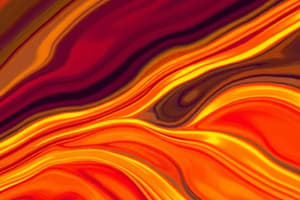Podcast
Questions and Answers
What is conduction?
What is conduction?
The transfer of heat through materials as particles collide and transfer energy to neighboring particles.
In which state of matter does conduction occur quickest?
In which state of matter does conduction occur quickest?
- Solids (correct)
- Gases
- Liquids
Convection is the process of hot fluids rising and cold fluids sinking.
Convection is the process of hot fluids rising and cold fluids sinking.
True (A)
What happens to the density of liquids and gases when they are heated?
What happens to the density of liquids and gases when they are heated?
What is radiation?
What is radiation?
What type of energy is generated from natural sources and can be reused?
What type of energy is generated from natural sources and can be reused?
Name one advantage and two disadvantages of using fossil fuels as energy sources.
Name one advantage and two disadvantages of using fossil fuels as energy sources.
Which of the following is NOT a type of renewable energy?
Which of the following is NOT a type of renewable energy?
What energy transformation occurs in a wind turbine?
What energy transformation occurs in a wind turbine?
What common household appliance often has a freezer unit, is more economical to run if designed correctly?
What common household appliance often has a freezer unit, is more economical to run if designed correctly?
What is the definition of energy?
What is the definition of energy?
What is potential energy?
What is potential energy?
What is active energy?
What is active energy?
Energy can only be detected when it is active.
Energy can only be detected when it is active.
What is the unit for measuring energy?
What is the unit for measuring energy?
Energy cannot be created out of nothing. It can change form, but the total amount stays the same. Energy cannot be __________.
Energy cannot be created out of nothing. It can change form, but the total amount stays the same. Energy cannot be __________.
Energy can be transferred to a form that is not useful or wanted. For example, in a light bulb, electrical energy converts to __________ energy and __________ energy.
Energy can be transferred to a form that is not useful or wanted. For example, in a light bulb, electrical energy converts to __________ energy and __________ energy.
What are the two categories of energy?
What are the two categories of energy?
Which of the following describes conduction?
Which of the following describes conduction?
What is the primary reason heat flows from a hot object to a cold object?
What is the primary reason heat flows from a hot object to a cold object?
Flashcards are hidden until you start studying
Study Notes
What is Energy?
- Energy enables objects and organisms to perform work or actions.
- It is measured in joules (J), a key unit in scientific studies.
Types of Energy
- Two primary forms: Potential Energy (stored energy) and Active Energy (energy of movement).
- Potential energy is evident when transformed into active energy; for example, a battery demonstrates potential energy until it converts into electrical energy.
Law of Conservation of Energy
- Energy cannot be created or destroyed; it can only change forms.
- Total energy within a closed system remains constant despite transformations.
Energy Conversions
- Energy can transform from one type to another—for instance, chemical potential energy in a candle converts to heat and light as it burns.
- Energy transfer can occur through various purposes or functions like electrical energy powering a motor.
Heat Transfer Methods
- Conduction: Heat transfer through direct contact (e.g., metal conducts heat efficiently).
- Convection: Heat transfer in fluids where hot materials rise, and cold ones sink.
- Radiation: Transfer of energy through electromagnetic waves without needing a medium.
Energy Uses and Storage
- Living organisms use energy for various functions, including movement and metabolic processes.
- Energy storage examples include batteries storing chemical energy and bodies storing energy as fat for later use.
Temperature vs. Thermal Energy
- Temperature is the average kinetic energy of particles in a substance, measured in degrees Celsius.
- Thermal energy refers to the total kinetic and potential energy of particles, measured in joules.
Practical Applications
- Energy transformations can be observed through experiments involving various devices (e.g., windmills, light bulbs).
- Real-life energy scenarios can demonstrate the distinction between useful and wasted energy (e.g., light bulbs emit light but also produce heat as wasted energy).
Heat Transfer Investigation
- Investigations can illustrate heat transfer principles through conduction and convection.
- Experiments enable observation of how heat energy disperses through different materials and states of matter.
Summary Takeaways
- Understanding energy is crucial in science; its conservation and transformation are foundational concepts.
- Recognizing the ways heat is transferred enriches comprehension of thermal dynamics in materials and everyday life.### Heat Transfer - Convection
- A hangi uses hot stones to create steam in an earth oven to cook food efficiently.
- Steam cooks food faster when placed at the bottom of the oven because hot air rises and enhances heat distribution.
- Fridges with freezers located above the fridge generally consume more energy than those with freezers below due to heat distribution dynamics.
Basics of Convection
- Convection is a heat transfer method occurring in liquids and gases.
- Heating causes liquids and gases to become less dense, making them rise.
- Particle movement increases in size as liquids and gases are heated, leading to less density.
Heat Transfer - Radiation
- Radiation is heat transfer that takes place without direct contact between the heat source and the object.
- Heat is transmitted through electromagnetic waves, even through empty space, exemplified by heat from the Sun.
Absorbing Heat by Radiation - Investigation
- A black can and a silver can with tap water are tested for heat absorption near a heater.
- Predictions can be made based on differing heat absorption levels between materials.
Emitting Heat by Radiation - Investigation
- A similar experiment involves measuring how much heat is emitted from black and silver cans containing warm water.
- The different temperature changes help assess the emission capacity of materials.
Energy Generation
- Energy sources are categorized into renewable and non-renewable types, impacting sustainability and availability.
Renewable Energy
- Renewable energy comes from natural sources and can be reused, heavily depending on sunlight.
- Types include:
- Solar
- Wind Power
- Hydroelectric Energy
- Geothermal Power
- Biomass
- Hydrogen and Fuel Cells
Non-Renewable Energy
- Non-renewable energy sources are limited and regenerate slowly, leading to potential energy crises.
- Types include:
- Coal
- Oil
- Natural Gas
- Nuclear Energy
Key Concepts for Revision
- Understand different energy types and the Law of Conservation of Energy.
- Energy is quantified in joules.
- Familiarize with energy conversions and how heat is transferred via conduction, convection, and radiation.
- Utilize revision materials and exercises for comprehensive understanding and self-assessment through flashcards or summary notes.
Studying That Suits You
Use AI to generate personalized quizzes and flashcards to suit your learning preferences.




